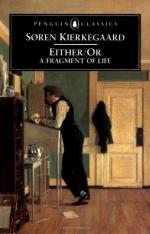|
This section contains 372 words (approx. 1 page at 400 words per page) |

|
Either/Or Summary & Study Guide Description
Either/Or Summary & Study Guide includes comprehensive information and analysis to help you understand the book. This study guide contains the following sections:
This detailed literature summary also contains Topics for Discussion and a Free Quiz on Either/Or by Søren Kierkegaard.
Soren Kierkegaard is one of the prominent philosophical thinkers of the 19th century. This man is also famed for being the only Scandinavian to turn up in the international group of Modern European Philosophers of that century. The work summarized is a precious English translation. The work of translation had apparently begun as an almost guilty secret by a man named Lowrie. After he died, through his surviving wife his secluded efforts were revealed and the project of completing the work was continued. Thanks to that, there is the English edition of Either/Or, which consists solely of volume 2.
The author has made an effort to formulate a sophisticated look at marriage. There are two major elements involved. One of these is aesthetic, whereas another is ethical. Kierkegaard explores and theorizes regarding this social custom. His cultural context was so much more conservative than large tracts of contemporary America that he suffered a scandal and fled all the way to Berlin because he had become engaged to a woman and now wanted to break up with her instead of following through with the marriage. That this was seen as scandalous indicates that the culture was conservative.
There are two main parts to the text. The first is the Aesthetic Validation of Marriage. The second is called Equilibrium. The first is a lengthy discourse on multiple aspects of the marital relationship. This is done rather in terms of arguments in favor of it, with the recognition of arguments against it. The second is about other attributes of the conventional middle class man's life. Parts of this role have become familiar to modern women, sometimes voluntarily as a means to self-improvement, but other times due to troubles in relationships with men. Over all, Soren Kierkegaard gives an ethical account of modern life. He compares two different lifestyles. He calls one the aesthetic, and the other he describes as ethical. He argues in favor of marriage, overcoming a variety of objections and communicating with the reader about possible anxieties and other problems. Ultimately, he brings the minds of readers back to God. For believers this is inspiring whereas for nonbelievers it is apt to "chaff" like an overly starched tight collar.
Read more from the Study Guide
|
This section contains 372 words (approx. 1 page at 400 words per page) |

|



